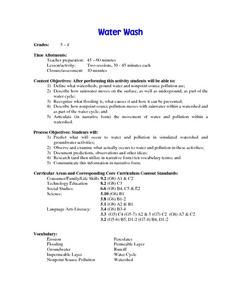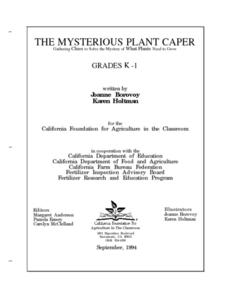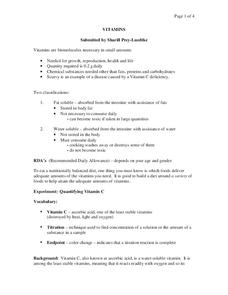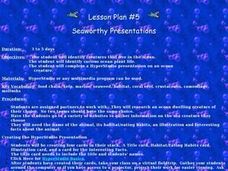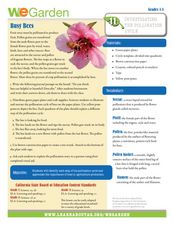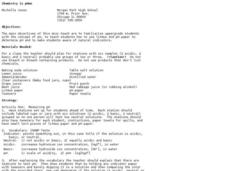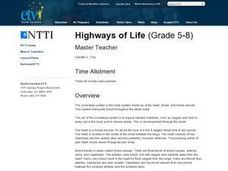Curated OER
Water Wash
Students define watersheds, ground water and nonpoint source pollution. They describe how rainwater moves on the surface, as well as underground, as part of the water cycle. They recognize what flooding is as well as its causes.
Curated OER
Ooblek
Students demonstrate the three states of matter. In this matter lesson, students read Bartholomew and the Ooblek. Students create "ooblek" and discuss what state of matter it is.
Curated OER
The Spider's Life Cycle
Students see that spiders have a life cycle, and reproduce by laying many eggs. We can count by ones, twos, fives, or as many as we want. They make two lists of animals on a chart.
Curated OER
The Mysterious Plant Caper
Students investigate the basic parts of plant and that plants are living things which require water, air, light and nutrients for survival. They do this through a series of scientific experiements and multi-curricular hands-on activities.
Curated OER
Peter Rabbit Meets Charles Darwin
Students start to think of evolution in terms of populations. The class follows a cartoon scenario of a rabbit population in which there is selection and change of gene frequency. They receive copies of the scenario or the whole thing...
Curated OER
Pond Theme Unit
In this pond theme instructional activity students research facts on pond life. Students complete comprehension questions, crosswords, word search, and math puzzles. Students write a short report.
Curated OER
Vitamins
Students determine the amount of vitamin C present in 3 samples of juice stored in various light conditions. In this vitamin lesson plan, students investigate the amount of vitamin C present in juice exposed to different quantities of...
Curated OER
Healthy Heart
Students discover the power of their heart and provide an opportunity to talk about ways to maintain good health. In this early childhood heart lesson, students diagram a human heart, identify exercises that promote a healthy heart, and...
Curated OER
Composition of the Atom
Learners investigate the structure of the atom and its composition. In this atom structure lesson, students find the area of cut out circles and drop pens into the circles. They count the number of marks in the circles and relate their...
Curated OER
World of Plastics and Polymers
Students investigate plastics and learn they are giant molecules made of carbon atoms. In this polymers and plastics lesson, students perform 3 activities which all include making polymers from household items such as milk and vinegar,...
Curated OER
Animal Habitats
Students research an animal and their habitat. In this animal habitat lesson, students observe a WebQuest that describes the different habitats: deserts, tundra, rainforest, forest, and ocean. They determine which habitat their animal...
Curated OER
Endangered Species: Not Only Animals
Students research endangered animals and plants. In this biology instructional activity, students are read Will We Miss Them? Endangered Species by Alexandra Wright before they begin searching for information to complete an...
Curated OER
Seaworthy Presentations
First graders research ocean animals and plants on the web. In this ocean habitat lesson, 1st graders prepare a multimedia presentation. Students will work on their presentations in pairs and every group should have its own...
Curated OER
Busy Bees
Students explore the pollination cycle. For this pollination lesson, students investigate the process of pollination. Students illustrate the pollination cycle of bees on paper plates.
Curated OER
River System
Fifth graders explore the parts of a river system and understand the importance of each part. For this river system lesson, 5th graders diagram a river system and write a paragraph explaining its parts.
Curated OER
Gray Whales
Explore the majestic grey whale while deepening your understanding of animal adaptations. Grey whales from head to toe are specifically designed to fit their environment. Learners will examine the ways in which the flippers, head, body,...
Curated OER
Chemistry is pHun
High schoolers investigate the pH of solutions and they learn how to use different types of indicators. In this pH lesson plan, students test various solutions with pH paper and determine if they are acidic, basic or neutral. They also...
Curated OER
Learning About Animal Shelters for Earth Day
Students explore habitats. in this ecology and animal habitat lesson, students listen to the book A House is a House for Me by Mary Ann Hoberman. Students discuss the basic needs of animals and go on a nature walk to observe animal...
Curated OER
Repopulating Michigan's Waterways
Eleventh graders identify the parts of an ecosystem and how communities change over time. In this ecology lesson plan students formulate a habitat restoration plan.
Curated OER
Living in Extreme Environments: Havens on the Deep Sea Floor
Students identify the characteristics of an extreme environment in the deep ocean and consider what organisms need to survive in these elements. They research sampling and data collection methods in this environment.
Curated OER
the biggest Plates on Earth
Students understand the movement of tectonic plates. In this tectonic plates activity, students access prior knowledge of convergent, divergent, and transform boundaries. Students discuss energy transfer involved in plate...
Curated OER
Insect Conservation
Students make a diorama. In this insect lesson plan, students review what they know and what they need to know about insects. Students define conservation, discuss why it is important to conserve insects, and make an insect diorama.
Curated OER
Plants, Animals and Our Environment
Students draw and label the basic needs of animals. They draw and label the basic needs of plants. Students understand the basic needs of plants and animals are not only the same, but are interrelated. They know that the environment...
Curated OER
Highways of Life
Young scholars explore the circulatory system. They participate in media activities to explore blood flow and identify the parts of the circulatory sytem. Students create a model of the circulatory system.
